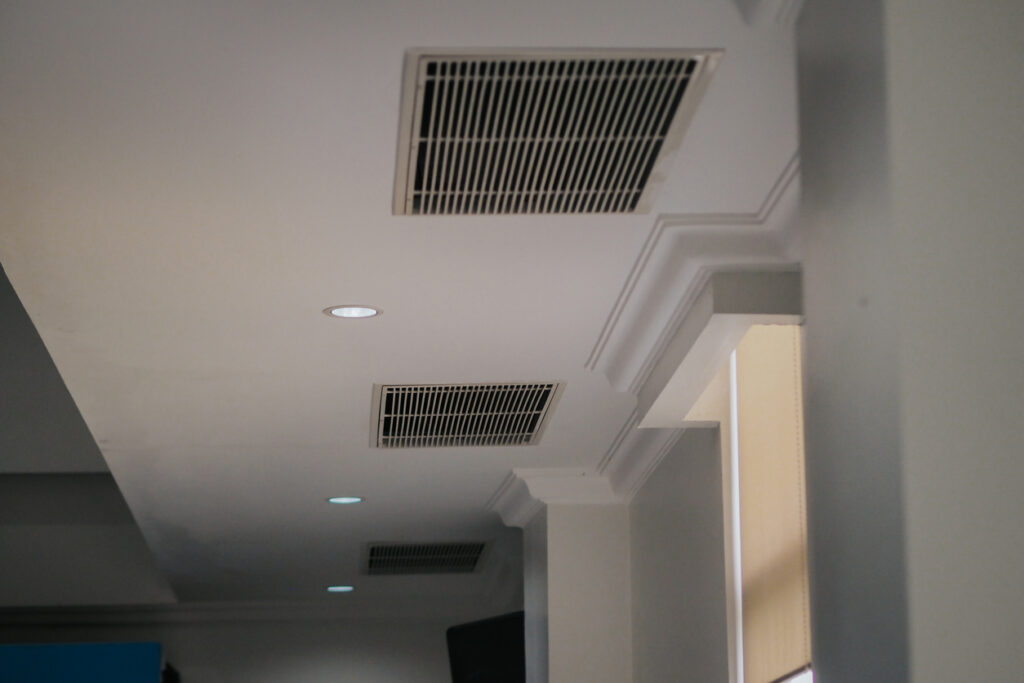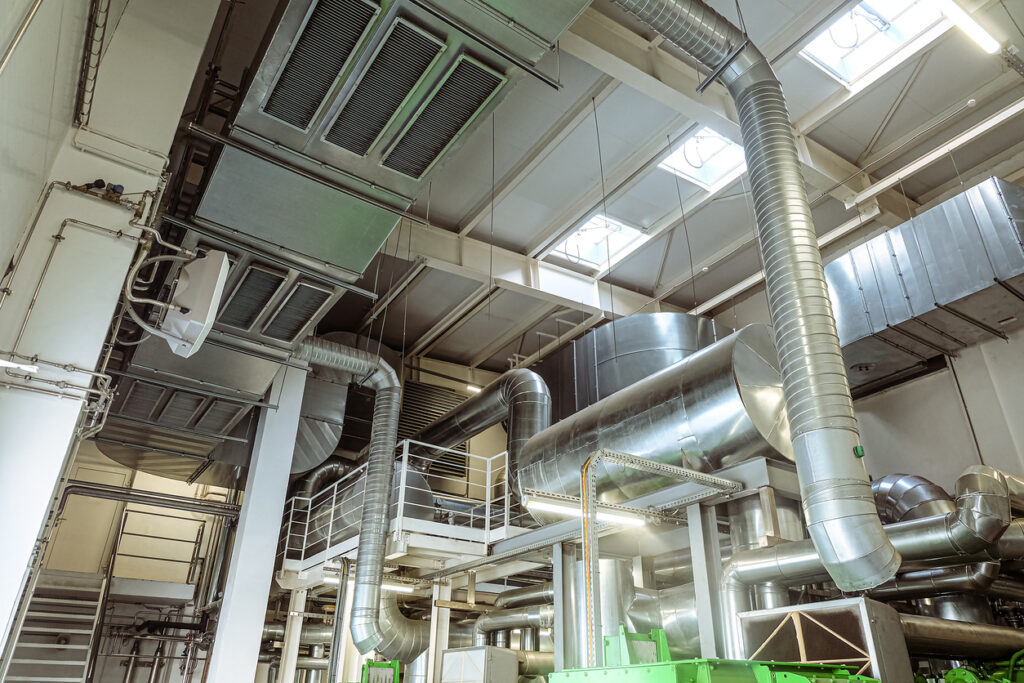Elevate Your Indoor Air Quality with Commercial and Industrial Solutions
Indoor air quality (IAQ) refers to the purity of the air within a building, directly impacting occupant health, comfort, and operational efficiency. Poor IAQ allows pollutants to build up, leading to respiratory irritation, sick building syndrome, and reduced productivity. By investing in targeted ventilation upgrades, advanced purification systems, and rigorous maintenance, businesses can transform their workspaces into safer, more efficient environments. This article explores the key benefits of improved IAQ, discusses commercial ventilation enhancements, examines industrial purification technologies, reviews testing and monitoring services, details preventative HVAC maintenance, explains US regulatory standards, and finally, demonstrates why Morris Mechanical’s expertise delivers optimal indoor air solutions.
In the following sections, you’ll discover:
- The health, financial, and well-being advantages of superior IAQ in commercial buildings.
- Strategies for optimizing ventilation systems, including demand-controlled and energy recovery ventilators.
- Industrial air purification options such as HEPA, UV-C, and activated carbon filters.
- Best practices for IAQ assessment, continuous monitoring, and pollutant detection.
- Preventative HVAC maintenance schedules and filter replacement strategies.
- Key ASHRAE, EPA, and workplace compliance requirements.
- The reasons Morris Mechanical’s 55+ years of reliable commercial and industrial HVAC service make them the partner of choice.
What Are the Key Benefits of Improving Indoor Air Quality in Commercial Buildings?
How Does Better IAQ Boost Employee Health and Productivity?
Enhanced indoor air quality reduces airborne contaminants that trigger allergic reactions and respiratory distress, directly supporting occupant wellness and efficiency. By increasing fresh air exchange and filtering fine particulates, businesses create healthier environments that lower absenteeism and improve focus. Studies indicate that cleaner air can boost cognitive function by up to 11 percent and reduce sick days, with staff reporting clearer thinking and sustained energy throughout the workday. Enhanced ventilation and filtration thus form a critical component of any productivity-driven facility strategy, aligning health outcomes with operational goals.
Key impacts of superior IAQ include:
- Improved concentration and decision-making through reduced CO₂ and VOC levels.
- Lower incidence of headaches and respiratory symptoms, cutting downtime.
- Enhanced morale and staff retention due to a demonstrable commitment to well-being.
These benefits underpin the financial advantages gained by organizations that prioritize air purity.
What Are the Financial Advantages of Enhanced Indoor Air Quality?
Enhanced indoor air quality delivers tangible cost savings by reducing energy consumption and minimizing health-related disruptions. Efficient air handling and heat recovery systems cut utility bills by up to 20 percent, while decreased sick building syndrome cases limit medical and HR expenses. Over a typical contract period, optimized IAQ solutions can achieve payback through energy savings and reduced absenteeism in under two years. Aligning IAQ improvements with preventative HVAC maintenance extends equipment lifespan, lowering replacement and repair outlays. Ultimately, financial returns reinforce the business case for comprehensive air quality programs that combine engineering precision with operational foresight.
Advanced IAQ investments thus generate dual returns: immediate operational savings and long-term asset preservation, establishing a robust foundation for sustainable facility management.
How Does IAQ Reduction of Sick Building Syndrome Improve Workplace Wellbeing?
Reducing sick building syndrome (SBS) involves eliminating the root causes of occupant discomfort—stagnant air, chemical pollutants, and microbial growth. By increasing fresh air exchange and installing targeted filtration, workplaces experience fewer reports of eye irritation, fatigue, and throat dryness. A well-maintained HVAC system that controls humidity and removes mold spores creates a more comfortable environment, reinforcing occupant resilience. Addressing SBS through IAQ strategies fosters a culture of care, signaling to employees that their health and comfort are a strategic priority within commercial and industrial settings.
Enhanced workplace well-being then transitions naturally into exploring how ventilation system upgrades form the backbone of IAQ improvement programs.
How Can Commercial Ventilation System Upgrades Improve Indoor Air Quality?

What Is Demand-Controlled Ventilation and How Does It Work?
Demand-controlled ventilation (DCV) automatically adjusts fresh air intake based on real-time CO₂ and occupancy data, ensuring optimal air exchange precisely when needed. Sensors monitor pollutant concentrations and trigger fans to increase airflow during peak occupancy, then scale back during low usage to conserve energy. This intelligent modulation maintains ideal indoor conditions while avoiding the waste associated with constant full-volume ventilation. DCV not only controls contaminants but also reduces heating and cooling loads, delivering both IAQ and efficiency benefits through a single technological investment.
Demand-Controlled Ventilation (DCV) for Enhanced Indoor Air Quality and Energy Efficiency
In a Demand-Controlled Ventilation (DCV) system, the ventilation airflow rate is continuously adjusted to match the actual demand. Consequently, the DCV system ensures that ventilation is provided only when and where it is required. This results in significant energy savings, as less energy is consumed for fan operation and air conditioning when demand is low. Furthermore, DCV systems can improve indoor air quality by ensuring adequate ventilation during periods of high occupancy or elevated pollutant levels, thereby preventing the accumulation of contaminants.
Demand controlled ventilation (DCV) for better IAQ and Energy Efficiency, 2011
By precisely matching ventilation rates to actual demand, DCV systems create healthy indoor climates without unnecessary energy expenditure, setting the stage for further energy recovery strategies.
DCV Systems: Energy Efficiency and Air Quality in Commercial Buildings
Demand-controlled ventilation (DCV) refers to a ventilation system that adjusts the quantity of fresh air supplied to a building based on actual demand, typically determined by occupancy levels or pollutant concentrations. In contrast to traditional constant ventilation systems, DCV operates at reduced airflow rates for a significant portion of its operational time, thereby consuming less energy. This energy efficiency, coupled with the ability to maintain good indoor air quality, renders DCV a valuable strategy for commercial and industrial buildings.
Demand controlled ventilation (DCV) in school and office buildings: Lessons learnt from case studies, B Merema, 2018
What Are the Benefits of Energy Recovery Ventilators for Businesses?
Energy recovery ventilators (ERVs) capture thermal energy from exhaust air and transfer it to incoming fresh air, minimizing heating and cooling costs. This heat-exchange mechanism preserves conditioned air quality while ensuring continuous pollutant dilution. In colder months, ERVs reclaim up to 75 percent of heat energy, and in warmer seasons, they pre-cool incoming air, lowering central HVAC loads. The result is consistent IAQ, reduced carbon footprint, and enhanced comfort for occupants year-round.
Ordered List of ERV Advantages:
- Recovers latent and sensible heat to reduce HVAC energy use.
- Balances humidity to prevent mold growth and stagnant air.
- Operates with minimal maintenance under preventative service plans.
These features illustrate why integrating energy recovery into ventilation designs is essential for long-term IAQ performance and cost control.
Why Is Regular Ductwork Cleaning Essential for IAQ?
Routine ductwork cleaning prevents the accumulation of dust, debris, and microbial contaminants that diminish filtration effectiveness and promote pollutant recirculation. Over time, duct interiors can harbor mold spores, pollen, and pet dander, compromising air purity and straining HVAC components. Professional cleaning restores optimal airflow, reduces system wear, and ensures that high-efficiency filters perform to specification. When ducts remain clear, fresh air delivery is maximized, and energy efficiency gains from ventilation upgrades are fully realized.
Clear ducts thus form an indispensable complement to both DCV and ERV technologies, maintaining system efficiency and sustaining healthy indoor environments.
Which Industrial Air Purification Systems Are Most Effective for IAQ?

Industrial air purification systems combine multiple filtration and disinfection technologies to tackle a broad spectrum of pollutants and pathogens. High-capacity units remove particulates, neutralize chemical vapors, and inactivate airborne microbes, creating safe conditions in manufacturing, warehousing, and processing facilities. Selecting the right combination of HEPA, UV-C, and activated carbon modules ensures comprehensive contaminant control tailored to site-specific challenges. This section examines three core purification methods that underpin industrial IAQ excellence.
| Technology Type | Primary Function | Key Benefit |
|---|---|---|
| HEPA Filtration | Captures 99.97 percent of particles | Removes dust, pollen, and mold spores to protect health |
| UV-C Disinfection | Destroys bacteria and viruses | Inactivates pathogens without chemical residues |
| Activated Carbon | Adsorbs volatile organic compounds | Eliminates odors and harmful VOCs from process areas |
How Do HEPA Filters Remove Harmful Particulates in Industrial Settings?
HEPA filters capture particles as small as 0.3 microns through a combination of interception, diffusion, and impaction mechanisms. Airborne contaminants collide with or adhere to dense fiberglass media, effectively removing dust, pollen, and fine soot before air re-enters occupied zones. By integrating HEPA modules into existing HVAC or standalone equipment, facilities achieve near-complete particulate removal, reducing respiratory hazards and protecting sensitive processes. Regular filter inspections and timely replacements ensure that capture efficiency remains at rated performance levels.
This particulate control capability leads us seamlessly to ultraviolet disinfection’s role in pathogen management.
What Role Does UV-C Air Purification Play in Workplace IAQ?
UV-C irradiation uses short-wave ultraviolet light to disrupt microbial DNA and RNA, neutralizing bacteria, viruses, and mold spores as air passes through purification chambers. This chemical-free approach eliminates airborne pathogens without introducing secondary pollutants, promoting a hygienic environment in high-risk areas such as healthcare, food processing, and laboratories. When paired with particulate filtration, UV-C modules create a dual-action barrier that addresses both biological and particulate threats. Incorporating UV-C into central air systems or portable units extends its benefits across large industrial spaces.
Integrating UV-C technology next highlights how activated carbon filters tackle chemical contaminants.
How Do Activated Carbon Filters Help Remove VOCs and Odors?
Activated carbon filters rely on porous carbon granules with vast surface area to adsorb volatile organic compounds (VOCs) and odorous molecules. Polluted air passing through these filters binds organic vapors to carbon surfaces, effectively reducing chemical exposures associated with paint shops, printing presses, and solvent storage. By addressing odors alongside VOCs, carbon modules improve occupant comfort and regulatory compliance in industrial operations. Periodic replacement of spent carbon ensures ongoing adsorption capacity and consistent odor control.
VOC Adsorption Filters for Indoor Air Purification in HVAC Systems
Volatile organic compounds (VOCs) have detrimental effects on health. Adsorptive filters integrated into HVAC systems can effectively remove these harmful pollutants from the air. To facilitate the comparison of different HVAC filter media, the standard ISO 10121-1 specifies test methods for evaluating their performance in capturing VOCs and other contaminants, thereby enhancing indoor air quality.
Prediction of VOC adsorption performance for estimation of service life of activated carbon based filter media for indoor air purification, C Asbach, 2019
The synergy of HEPA, UV-C, and activated carbon technologies provides a comprehensive framework for industrial air purification that delivers measurable IAQ improvements.
What Are the Best Indoor Air Quality Testing and Monitoring Services for Businesses?
How Is a Commercial IAQ Assessment Conducted?
A commercial IAQ assessment begins with a site survey to identify potential pollution sources, occupancy patterns, and HVAC system design. Certified technicians collect air samples for laboratory analysis of particulates, VOCs, CO₂, humidity, and microbial contaminants. Portable gas detectors and particle counters provide real-time data, while longer-term passive samplers reveal pollutant trends. Combined with moisture mapping and visual inspections, this multi-modal approach yields a detailed air quality profile. Results guide tailored remediation plans, prioritizing ventilation upgrades, advanced filtration, or targeted purification as required.
Comprehensive assessments form the basis for selecting continuous monitoring solutions that sustain optimal IAQ.
What Pollutants Are Commonly Detected in Indoor Air Quality Tests?
Indoor air quality tests routinely screen for chemical and biological hazards that affect health and comfort. Typical target analytes include:
tests routinely screen for chemical and biological hazards that affect health and comfort. Typical target analytes include:
- Carbon dioxide (CO₂) – an indicator of ventilation effectiveness.
- Volatile organic compounds (VOCs) – solvents, cleaning agents, and off-gassing materials.
- Particulate matter (PM₂.₅ and PM₁₀) – dust, pollen, and combustion by-products.
- Humidity and mold spores – moisture levels that support microbial growth.
- Formaldehyde and other aldehydes – building material emissions in older structures.
Understanding the pollutant spectrum enables precision interventions, enhancing both air purity and regulatory compliance.
How Do Real-Time IAQ Monitoring Systems Help Maintain Air Quality?
Real-time IAQ monitoring systems continuously track key parameters such as CO₂, VOCs, temperature, and humidity, delivering live alerts when thresholds are exceeded. This data drives automated ventilation adjustments, filter change notifications, and targeted purification system activation to prevent contaminant build-up. Dashboards visualize trends over time, enabling facility managers to fine-tune building management strategies and demonstrate compliance to auditors. By maintaining constant situational awareness, businesses sustain optimal indoor conditions and avoid the reactive costs of intermittent testing.
Continuous monitoring thus completes the IAQ management cycle, linking assessment to proactive system control.
How Does Preventative HVAC Maintenance Support Optimal Indoor Air Quality?
What Are Recommended HVAC Maintenance Schedules for IAQ?
Preventative HVAC maintenance involves regular inspections, cleaning, and component servicing to preserve system performance and air purity. Key activities include quarterly filter checks, bi-annual duct inspections, and annual coil cleaning to remove accumulated grime. Scheduled lubrication of fans and motor bearings ensures steady airflow, while calibration of sensors maintains accurate demand-controlled ventilation. A disciplined maintenance calendar minimizes unexpected failures and sustains design-specification IAQ levels throughout the building lifecycle.
Adhering to these maintenance intervals supports both air quality goals and energy efficiency targets, preparing systems for timely filter replacements.
How Does Timely Filter Replacement Improve Air Quality?
Replacing air filters at manufacturer-recommended intervals prevents clogging, pressure drop, and microbial growth within filter media. Fresh filters restore design airflow rates, ensuring that incoming air traverses full-capacity media rather than bypassing clogged sections. High-efficiency filters regain their rated particulate capture and, when combined with carbon or UV-C modules, maintain comprehensive pollutant control. Consistent filter replacement under a preventative contract maximizes system lifespan and avoids performance degradation that undermines IAQ improvements.
Effective scheduling of filter changes transitions us into how maintenance reduces sick building syndrome incidence.
How Can Maintenance Help Prevent Sick Building Syndrome?
Regular HVAC servicing removes pollutant reservoirs such as stagnant condensate, mold accumulation, and duct dust that contribute to sick building syndrome. Cleaning coils, drip pans, and drain lines prevents microbial proliferation, while verifying proper airflow distribution eliminates stagnation zones. Inspections detect refrigerant leaks and ensure humidity control, both critical for mitigating SBS triggers. By maintaining clean, balanced air systems, businesses create environments that support occupant health, comfort, and productivity.
This preventative approach not only preserves IAQ but also reinforces operational continuity and regulatory compliance.
What Are the Key US Regulations and Standards for Commercial Indoor Air Quality?
What ASHRAE Standards Apply to Commercial IAQ?
ASHRAE Standard 62.1 sets minimum ventilation rates and indoor air quality criteria for commercial buildings, specifying per-occupant and per-area air supply requirements. It outlines procedures for system design, airflow measurement, and performance verification to ensure contaminant dilution. The standard also addresses acceptable indoor pollutant concentration limits, including particulates, CO₂, and bio-aerosols. Compliance with ASHRAE guidance assures both health-based ventilation rates and energy-efficient strategies through demand-controlled and recovery ventilator technologies.
These guidelines form the technical backbone for meeting broader EPA recommendations and workplace safety regulations.
How Do EPA Guidelines Influence Workplace Air Quality Management?
EPA publications provide practical recommendations for identifying and managing indoor pollutants, emphasizing source control, ventilation, and air cleaning. Documents such as “An Office Building Occupant Survey” guide businesses in monitoring occupant symptoms and evaluating building performance. EPA also publishes reference methods for sampling formaldehyde, radon, and asbestos, helping facility managers prioritize remediation. While not legally enforceable, EPA guidelines inform best practices and support compliance with mandatory state and local air quality regulations.
EPA’s holistic approach then complements OSHA’s enforcement of health and safety standards in indoor environments.
What Are Health and Safety Compliance Requirements for Indoor Environments?
Occupational Safety and Health Administration (OSHA) regulations mandate safe indoor air under the General Duty Clause, requiring employers to maintain workplaces free from recognized hazards. Specific guidelines address ventilation, chemical exposure limits, and respiratory protection programs. State and local building codes may impose additional IAQ requirements, including radon mitigation, mold remediation, and formaldehyde control. Adhering to these standards ensures legal compliance, reduces liability, and fosters healthier workspaces that support employee well-being and retention.
Aligning system design and maintenance with these regulations completes a robust IAQ compliance framework.
Why Choose Morris Mechanical for Your Indoor Air Quality Solutions?
How Does Morris Mechanical’s 55+ Years of Expertise Benefit Your Business?
Morris Mechanical’s decades of HVAC engineering and service deliver unmatched reliability in IAQ optimization projects. Years of experience have refined methodologies for ventilation upgrades, advanced filtration, and preventative maintenance, resulting in consistently high system performance. Clients benefit from rapid response through 24-hour coverage and expertly engineered plans tailored to commercial and industrial workflows. This combination of heritage expertise and round-the-clock support ensures peace of mind and uninterrupted indoor air management.
Their track record of success underpins the comprehensive service offerings detailed below.
What Comprehensive IAQ Services Does Morris Mechanical Offer?
Morris Mechanical provides end-to-end IAQ solutions, including:
- Professionally engineered ventilation system design and installation.
- Industrial-grade air purification strategies integrating HEPA, UV-C, and carbon filtration.
- Full-service IAQ assessments, pollutant testing, and continuous monitoring setups.
- Preventative HVAC maintenance contracts with scheduled filter changes and duct cleaning.
- Regulatory compliance consulting aligned with ASHRAE, EPA, and OSHA standards.
By combining these services, Morris Mechanical delivers holistic air quality programs that safeguard health, enhance productivity, and optimize energy use.
How Can You Request a Quote or Schedule an IAQ Assessment?
To arrange a customized indoor air quality evaluation or obtain a detailed service proposal, contact Morris Mechanical’s expert team. Their client-focused process begins with a site consultation to define objectives, followed by an engineered plan for ventilation, purification, and maintenance. Flexible service agreements and rapid response ensure projects align with operational calendars. Engaging Morris Mechanical transforms IAQ aspirations into measurable improvements, offering facility managers and property owners the assurance of trusted expertise.



